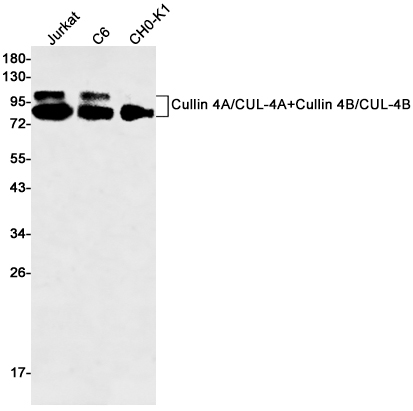-
Product Name
Anti-Cullin 4A/CUL-4A+Cullin 4B/CUL-4B Rabbit antibody
- Documents
-
Description
Cullin 4A/CUL-4A+Cullin 4B/CUL-4B Rabbit monoclonal antibody
-
Tested applications
WB, IHC-P, FC
-
Species reactivity
Human, Mouse, Rat
-
Alternative names
SFM2; MRXSC; CUL-4B; MRXHF2; MRXS15 antibody
-
Isotype
Rabbit IgG
-
Preparation
Antigen: A synthetic peptide of human Cullin 4B
-
Clonality
Monoclonal
-
Formulation
50nM Tris-Glycine(pH 7.4), 0.15M Nacl, 40%Glycerol, 0.01% sodium azide and 0.05% BSA.
-
Storage instructions
Store at 4°C short term. Store at -20°C long term. Avoid freeze / thaw cycle.
-
Applications
WB: 1/1000-1/5000
IHC: 1/20-1/50
FC: 1/20
-
Validations

Western blot detection of Cullin 4A/CUL-4A+Cullin 4B/CUL-4B in Jurkat,C6,CHO-K1 cell lysates using Cullin 4A/CUL-4A+Cullin 4B/CUL-4B Rabbit mAb(1:500 diluted).Predicted band size:88-104kDa.Observed band size:88-104kDa.
-
Background
Swiss-Prot Acc.Q13620.Core component of multiple cullin-RING-based E3 ubiquitin-protein ligase complexes which mediate the ubiquitination and subsequent proteasomal degradation of target proteins. The functional specificity of the E3 ubiquitin-protein ligase complex depends on the variable substrate recognition subunit. CUL4B may act within the complex as a scaffold protein, contributing to catalysis through positioning of the substrate and the ubiquitin-conjugating enzyme. Plays a role as part of the E3 ubiquitin-protein ligase complex in polyubiquitination of CDT1, histone H2A, histone H3 and histone H4 in response to radiation-induced DNA damage. Targeted to UV damaged chromatin by DDB2 and may be important for DNA repair and DNA replication. Required for ubiquitination of cyclin E, and consequently, normal G1 cell cycle progression. Regulates the mammalian target-of-rapamycin (mTOR) pathway involved in control of cell growth, size and metabolism. Specific CUL4B regulation of the mTORC1-mediated pathway is dependent upon 26S proteasome function and requires interaction between CUL4B and MLST8.
Related Products / Services
Please note: All products are "FOR RESEARCH USE ONLY AND ARE NOT INTENDED FOR DIAGNOSTIC OR THERAPEUTIC USE"
